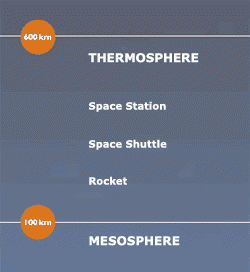The thermosphere and the exosphere are the outermost shells of the Earth’s atmosphere, in which artificial satellites and other spacecrafts like the International Space Station (ISS) follow orbits.
This part of the atmosphere is the natural environment for astronauts and cosmonauts, when they conduct a spacewalk to construct or repair space stations and to fetch or mend satellites.
Spacecraft aerodynamics and lifetime
The analysis of the variations in the orbits of artificial satellites has incidentally made a first important contribution to the study of the physic structure of this atmospheric layer. An in-depth knowledge of the atmosphere’s outermost part, that is to say of the thermosphere and the exosphere, is in itself important as fundamental research and is a part of a global study of the Earth’s environment.
For research and for applications in the field of geodesy, navigation, teledetection, and meteorology that knowledge has also resulted indispensable to:
- determine the aerodynamic characteristics of spacecrafts
- assess the duration during which spacecrafts can be active in an orbit around Earth
- select the most appropriate satellite orbits
When scientists, for instance, want to make long-term observations of Earth with high resolution, they choose a circular orbit that is not prone to all the possible disturbances which considerably alter the orbit, causing the satellites to return too soon.
The exosphere: the uppermost part of the atmosphere
The density of the atmosphere continuously decreases with height in such a way that, from a particular level, collisions between atoms become very infrequent. The mean free path, defined as the mean distance traversed by an atmospheric particle between two collisions, is roughly 100 km at 500 km height as compared with a value of a tenth of one micron at ground level!
The exosphere is defined as the atmospheric region where the number of collisions between particles are negligible.
The atoms follow different kinds of free-space trajectories and some of them can escape from the terrestrial atmosphere. The kinetic temperature loses its ordinary meaning and the hydrostatic law is no more valid. The critical level corresponding to the base of the exosphere is called "exobase" and is located between 350 and 800 km depending on the temperature at the thermopause.
Helium and hydrogen are the major exospheric constituents. The hydrogen atoms constitutes the corona of the atmosphere which extends to a height of 50.000 km.
The thermosphere: a part of the heterosphere
100 km altitude
The heterosphere is the atmospheric region where the composition is not homogeneous. The transition with the homosphere is located on the average at about the 100 km altitude where turbulent mixing is no more sufficient to maintain the air homogeneous. Molecular diffusion becomes the main phenomena.
The number density of each atmospheric constituent decreases with height at a rate which is directly proportional to its mass: the concentration of heavy constituents (O2 and N2) decrease faster than that of light constituents (O, He and H) in such a way that the relative abundances of the latter continuously increase with height.
Between altitudes of 100 and 150 km
On going upward, one meet several belts where molecular nitrogen, atomic oxygen, helium and hydrogen successively become the main constituent. The boundaries of these belts vary with the temperature linked itself to the level of solar activity.
Between the altitudes of 100 and 150 km, molecular oxygen is a strong absorber of solar extreme ultraviolet radiation at wavelengths between 100 and 200 nm: the resulting thermal effect is a large increase of the temperature with height in the thermosphere and located immediately above the mesosphere.
In the same time, many oxygen molecules (O2) dissociate into two oxygen atoms (O). Atomic oxygen becomes a main constituent. Taking into account of the heat transport by conduction, vertical profiles of the temperature can be calculated, depending also on diurnal and solar activity conditions.
Between 250 and 500 km
"Thermopause" is the name of the level at which the temperature stops rising. Its height depends on the solar activity and is located between 250 and 500 km. Above the thermopause, the atmosphere is isothermal and the temperature can take on values between 300°C and 1600°C.
The large size of this amplitude of temperature variations is linked to the extreme dilution of the atmosphere at these altitudes. The isothermal region has no specific name. It is usually assimilated into the thermosphere, at least up to the critical level where the exosphere begins.


